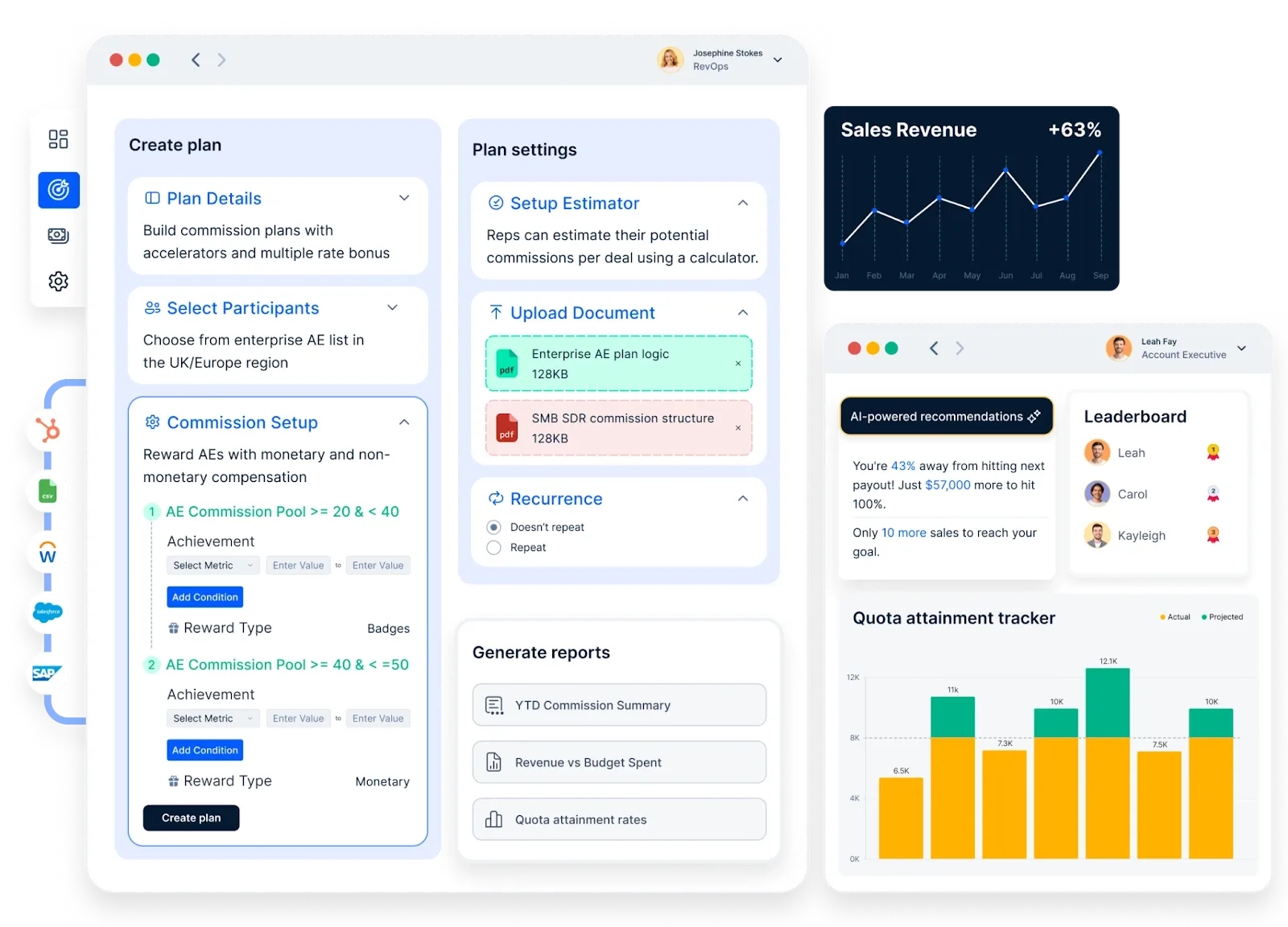14 Effective Sales and Channel Partner Commission Plan Examples to Try in 2025
Explore the best sales and channel partner commission plan examples. Learn how to design effective commission structures that motivate your team, drive sales, and achieve business goals. Discover key elements, best practices, and expert tips for creating commission plans that work.
On this page
Have you ever wondered why some companies have sales teams and channel partners that are always on fire, hitting targets month after month? The secret lies in a well-designed commission plan. It's like rocket fuel for your sales force, driving performance and keeping partners engaged.
A well-structured commission plan is a powerful tool to drive performance and keep everyone engaged. In this blog, we’re diving into various sales commission plan examples for sales teams and channel partners, showing how these plans can be your secret weapon for success.
Why are commission plans so crucial?
A commission plan is a structured system where employees or partners earn additional compensation based on their performance, typically linked to sales or revenue goals. These plans align individual and organizational objectives, encouraging sales reps and partners to strive for higher achievements.
Effective commission plans contribute to:
- Higher motivation and performance: Sales reps and partners work harder when their earnings directly reflect their results.
- Talent attraction and retention: Competitive commission plans attract top performers and help retain them.
- Stronger business growth: Companies that effectively implement commission structures report significantly higher sales performance.
Companies with strong commission plans report up to 44% higher sales performance than those without. Plus, these plans help attract top talent who are confident in their ability to perform and earn rewards.
The role of commission plans in sales motivation
Commission plans are not just about money; they’re about motivation and morale. Sales teams with clear, attainable commission structures often experience better job satisfaction and lower turnover rates. Partners who see tangible rewards for their efforts are more likely to stay loyal and continue pushing for success.
With a clear understanding of what commission plans are and why they matter, let's dive into the key elements that make up an effective commission plan.
Key elements of a commission plan
Following are the key elements of a commission plan:
1. Base salary vs. Commission
The balance between base salary and commission is crucial. A base salary provides financial stability, while commissions drive performance.
2. Commission structures
There are various types of commission structures, each suited to different business models and goals:
- Fixed commission: A straightforward approach where a fixed percentage is paid on every sale. For instance, a 5% commission on all sales.
- Tiered commission: This structure increases the commission rate as sales volume or targets are met. For example, 5% for the first $50,000 in sales, 7% for the next $50,000, and 10% for any amount beyond that.
- Revenue-based commission: Here, the commission is tied to the total revenue generated. This method is particularly effective for high-value sales environments.
- Profit-based commission: In this structure, commissions are based on the profit margin rather than total sales, encouraging sales reps to focus on high-margin products.
3. Incentives and bonuses
Beyond regular commissions, additional sales incentives and bonuses can further boost motivation. These might include:
- Performance bonuses: Extra payouts for exceeding targets or achieving certain milestones.
- Spiffs: Short-term incentives to push specific products or services.
- Non-monetary rewards: Things like trips, gadgets, or recognition awards can also be powerful motivators.
By understanding these key elements, you can create a commission plan that not only motivates your team but also aligns with your business goals.
Sales commission plan examples
Sales commission plans are vital in motivating and rewarding sales teams for their contributions to a company’s revenue growth. These plans can be tailored to suit various business models, sales strategies, and industry requirements.
Here are different sales commission structures with practical examples illustrating how businesses can effectively implement them.
1. Straight commission plan
In a straight commission plan, salespeople earn a commission based solely on their sales, with no fixed salary. This structure is common in industries where high performance is rewarded aggressively.
$500,000 × 5% = $25,000 commission
This structure highly motivates agents to close deals, as their income is directly tied to performance.
2. Base salary plus commission plan
This plan provides a fixed salary with an additional commission based on sales performance, balancing stability with motivation.
Base salary: $50,000 per year
Commission: 5% on all sales above $200,000 annually
If a salesperson generates $300,000 in sales, their commission is:
-($300,000 - $200,000) × 5% = $5,000
-Total earnings = $50,000 + $5,000 = $55,000
This approach ensures financial security while encouraging sales growth.
3. Tiered commission plan
Tiered commission plans offer increasing commission rates as salespeople achieve higher targets, driving them to exceed expectations.
- 5% commission on sales up to $500,000
- 7% commission on sales between $500,001 - $1,000,000
- 10% commission on sales exceeding $1,000,000
If a salesperson sells $1,200,000 worth of equipment:
- First $500,000 × 5% = $25,000
- Next $500,000 × 7% = $35,000
- Remaining $200,000 × 10% = $20,000
- Total Commission: $80,000
This plan pushes salespeople to aim for higher revenue brackets.
4. Revenue-based commission plan
In this model, salespeople earn a percentage of the total revenue they generate, aligning their goals with the company’s profitability.
10% commission on total ad sales revenue
For an ad campaign that generates $250,000 in revenue:
$250,000 × 10% = $25,000 commission
This ensures the sales team focuses on high-value deals.
5. Profit-based commission plan
Profit-based plans reward salespeople based on profit margins rather than revenue, promoting smart pricing and discount management.
- 5% commission on the profit margin of each sale
If a salesperson sells a machine for $100,000 with a profit margin of $20,000:
- $20,000 × 5% = $1,000 commission
This motivates salespeople to prioritize profitable deals.
6. Performance-based commission plan
Performance-based plans reward salespeople for achieving specific goals beyond just revenue, such as new customer acquisition or customer retention.
- Base commission: 4% on all sales
- Performance bonus: Additional 3% for acquiring more than 10 new customers in a quarter
If a salesperson sells $300,000 and acquires 12 new customers:
- $300,000 × (4% + 3%) = $21,000 commission
This ensures sales efforts align with broader business objectives.
7. Territory volume commission plan
This plan rewards salespeople based on the total sales volume within their assigned region.
- 2% commission on sales up to $1,000,000
- 4% commission on sales exceeding $1,000,000
If a salesperson generates $1,500,000 in their territory:
- First $1,000,000 × 2% = $20,000
- Remaining $500,000 × 4% = $20,000
- Total Commission: $40,000
This encourages regional market expansion.
8. Draw against commission plan
This plan provides an advance on future commissions, offering financial security while allowing salespeople to earn commissions beyond their draw amount.
- Monthly draw: $3,000
- Commission: 7% on all sales
If a salesperson generates $100,000 in sales for the month:
- $100,000 × 7% = $7,000
- Since the draw was $3,000, the final payout = $7,000 - $3,000 = $4,000 additional earnings
This structure ensures salespeople maintain steady income while aiming for higher commissions.
Channel partner commission plans examples
Channel partner commission plans play a crucial role in motivating and rewarding partners who help drive sales and expand market reach. These plans can vary widely depending on the industry, product, and strategic goals of a company. Here are common channel partner commission plan examples to provide a comprehensive understanding of how businesses can structure these incentives.
1. Tiered commission plans
A tiered commission plan rewards partners based on the volume of sales they achieve. For instance, a technology company might offer the following structure:
Tier 2: 7% commission on sales between $50,001 and $100,000.
Tier 3: 10% commission on sales exceeding $100,000.
This incentivizes partners to sell more, as higher sales volumes lead to higher commission rates.
2. Performance-based commission plans
Performance-based commission plans are tailored to reward partners who meet or exceed specific targets or metrics. A SaaS company might set goals for new customer acquisition or annual recurring revenue (ARR).
- New customer acquisition: 8% commission for acquiring up to 20 new customers and 12% for more than 20 new customers.
- ARR milestones: 6% commission on ARR up to $500,000, and 9% commission on ARR exceeding $500,000.
This structure encourages partners to focus on quality and long-term growth.
3. Revenue sharing plans
Revenue-sharing plans involve sharing a percentage of the revenue generated from sales with the channel partners.
Partners receive 20% of the revenue generated from the campaigns they bring in.
If the partner's efforts lead to additional business with the same client, they might receive an additional 5% on those sales.
This plan aligns the interests of the company and its partners, fostering a collaborative approach.
4. Product-specific commission plans
In industries with a diverse product range, companies might offer different commission rates for different products.
- High-margin products (e.g., flagship smartphones): 10% commission.
- Mid-range products (e.g., accessories): 7% commission.
-Low-margin products (e.g., entry-level gadgets): 5% commission.
This encourages partners to focus on selling high-margin items, benefiting both the partner and the company.
5. Spiff programs
Spiff programs offer short-term incentives or bonuses for achieving specific sales targets.
- Bonus for selling 50 units of a specific product: $200.
- Additional bonus for exceeding 100 units: $500.
These temporary incentives boost sales during critical periods.
6. Hybrid commission plans
A hybrid commission plan combines elements from different commission structures to suit complex sales environments.
- Base commission: 5% on all sales.
-Tiered bonus: Additional 3% for sales exceeding $100,000 in a quarter.
- Performance bonus: Extra 2% for meeting customer satisfaction targets.
This provides a balanced approach, rewarding both sales volume and customer satisfaction.
Channel partner commission plans are essential tools for motivating partners and aligning their efforts with the company’s strategic goals. By choosing the right structure, businesses can incentivize performance, drive sales growth, and build strong, lasting relationships with their channel partners.
How Compass automates commission management to maximize sales performance

Compass, a sales commission automation platform, helps businesses run effective sales compensation programs by automating and simplifying the management of incentive programs and compensation calculations. This automation drives top-line revenue by ensuring sales teams are motivated and compensated accurately and efficiently. Here’s how Compass can help streamline your sales compensation:
- Automation of incentive calculations: Compass automates the complex process of calculating sales commissions, ensuring accuracy and eliminating errors associated with manual calculations.
- Real-time visibility: Sales teams have real-time access to their earnings and performance metrics, which enhances transparency and motivation.
- Customization of compensation plans: The platform supports various compensation structures, making it flexible to cater to different sales roles and business needs.
- Integration with CRM Systems: Compass integrates with existing CRM systems, allowing for seamless data flow and reducing administrative overhead.
- Performance analytics: The platform provides detailed analytics on sales performance, which helps users make informed decisions to optimize their sales strategies.
- Scalability: Compass can scale with your business, supporting everything from small sales teams to large enterprises.
By leveraging Compass for sales compensation management, companies can ensure that their sales teams are focused on driving sales and achieving business goals rather than being bogged down by the intricacies of commission calculations.
Ready to simplify your sales compensation process and motivate your team like never before? Book a demo with our sales compensation experts to learn more and optimize your sales incentive programs today!
Let’s see how a German luxury auto brand boosts sales with Compass commission management:
A prestigious German luxury auto brand faced challenges in maintaining a competitive edge in the highly saturated luxury automotive market. Their primary goal was to enhance their top-line sales and improve the efficiency and motivation of their sales team.
The luxury auto brand's sales figures stagnated, and its sales teams struggled with low engagement. The primary challenges were outdated sales incentives and a lack of transparent communication regarding performance metrics and compensation. This led to decreased motivation among sales representatives, directly impacting their sales performance and, consequently, the company's overall revenue growth.
Solution
To address these challenges, the brand partnered with Compass to implement a comprehensive sales enhancement strategy that included:
- Sales commission management software: Introduction of Compass's sales commission management software to automate commission calculations and streamline payout processes.
- Sales gamification techniques: Implementation of sales gamification to boost sales team engagement and competition.
- Real-time sales analytics: Integration of advanced analytics tools that provided real-time insights into sales trends and individual performance metrics.
Results
Within just 90 days of implementing the new sales incentive program through Compass, the German luxury auto brand saw significant improvements in several key performance indicators:
- Top-line sales grew by 11%, directly attributable to increased sales activity and higher closing rates among the sales team.
- Sales team engagement soared, with a notable increase in sales reps' active participation in pursuing higher sales targets.
- Payout accuracy reached 96.2%, ensuring that sales reps were compensated correctly and promptly, boosting morale and trust in the system.
Conclusion
A well-structured commission plan is vital. They not only motivate sales teams and partners but also align their efforts with the company’s strategic goals. By understanding the different types of commission plans and incorporating best practices, businesses can create effective incentives that drive performance and growth.
Whether you opt for a flat commission, tiered structure, or performance-based rewards, the key is to design a plan that is clear, fair, and aligned with your business objectives.
Companies like Salesforce, Cisco, HubSpot, Microsoft, and Dell highlight how tailored commission plans can lead to significant improvements in sales performance and partner engagement.
As you consider implementing or revamping your commission plans, remember to communicate transparently, review regularly, and leverage technology to manage and track performance. By doing so, you can unlock the full potential of your sales and channel partners, driving success and achieving your business goals.
FAQs
1. What is the difference between a sales commission plan and a channel partner commission plan?
Sales commission plans are designed to incentivize a company's internal sales team, while channel partner commission plans reward external partners for promoting and selling the company's products or services.
2. How can technology help in managing commission plans?
Commission management software like Compass can automate calculations, track performance in real-time, and provide clear reports. This reduces administrative burden, ensures accuracy, and enhances transparency.
3. What is an example of a sales commission plan?
- Base salary plus commission: A salesperson at a high-end retail outlet might receive a base salary in addition to 5% of their sales1. The standard salary-to-commission ratio is usually around 60:40, with 60% fixed and 40% variable.
- Straight commission plan: A sales representative at a B2B SaaS startup could earn a 15% commission on every sale, without any base salary1. For example, landing a $10,000 deal would earn them $1,500.
- Absolute commission plan: A salesperson might get a flat dollar commission for each new customer they acquire, regardless of the deal size1. For instance, $500 per new customer.
- Tiered commission plan: A sales representative might receive 5% commission on sales up to $50,000; 7% on sales between $50,000 and $100,000; and 10% on sales above $100,000.
- Territory volume commission plan: If a team of five generates $750,000 in sales within their territory at a 10% commission, they would split the money and receive $15,000 each.
4. What is an example of SDR comp plan?
- Inbound SDR comp plan: With a $65,000 OTE (Base: $39,000), commission rates can be structured as: $500 for lead response time less than 5 minutes, $250 for less than 10 minutes, and $0 for over 10 minutes. Furthermore, $150/opportunity for 5+ qualified opportunities and $250/opportunity for 9+ qualified opportunities, along with 1% of all closed-won revenue booked by the SDR.
- Outbound SDR commission plan: With a $65,000 OTE (Base: $32,500), commission rates can be structured as: $400 for 1000 meaningful touches, $200 for 750 meaningful touches, and $0 for less than 750 meaningful touches. Additionally, $100/opportunity for 6+ sales accepted meetings and $250/opportunity for 11+ sales accepted meetings, plus 2% of all closed-won revenue booked by the SDR.
5. What is the partner commission structure?
This typically refers to the arrangement where a company pays a partner (e.g., a reseller, affiliate, or distributor) a commission for bringing in new business or generating sales. The structure can vary, with options like flat fees, percentage-based commissions, tiered commissions (based on sales volume), or performance-based incentives.
6. What is a good commission percentage for sales?
A good commission percentage can vary by industry and the specific sales role. Generally, sales commissions range from 5% to 20% of the sale value. Higher percentages may apply for high-margin products or complex sales processes, while lower percentages are common in industries with low margins or for inside sales roles.













